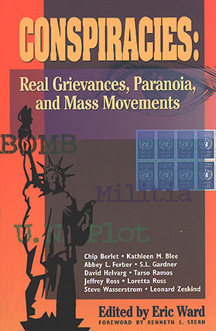 Zeskind differs from Hofstader, though, in arguing that conspiratorial thinking is not primarily a manifestation of individuals' economic distress or mental instability, but is a chosen political belief and worldview. Zeskind marshals convincing examples of this point, noting wryly that when Henry Ford published his imitation of the notoriously anti-Semitic hoax, the Protocols of the Learned Elders of Zion, in 1920 he was not suffering economically. During the Depression the Klu Klux Klan virtually disappeared. Sociologist James Aho, in his 1990 book The Politics of Righteousness, reported that Idahoan Christian patriots, a racist and anti-Semitic group, were "slightly better educated than Idahoans generally, were more likely to have stable families and maintained middle class (though slightly isolated) economic lives."
Zeskind differs from Hofstader, though, in arguing that conspiratorial thinking is not primarily a manifestation of individuals' economic distress or mental instability, but is a chosen political belief and worldview. Zeskind marshals convincing examples of this point, noting wryly that when Henry Ford published his imitation of the notoriously anti-Semitic hoax, the Protocols of the Learned Elders of Zion, in 1920 he was not suffering economically. During the Depression the Klu Klux Klan virtually disappeared. Sociologist James Aho, in his 1990 book The Politics of Righteousness, reported that Idahoan Christian patriots, a racist and anti-Semitic group, were "slightly better educated than Idahoans generally, were more likely to have stable families and maintained middle class (though slightly isolated) economic lives."
 |
 |
 |
 |
 |
Contents on this page were published in the January/February, 1997 edition of the Washington Free Press.
WFP, 1463 E. Republican #178, Seattle, WA -USA, 98112. -- WAfreepress@gmail.com
Copyright © 1997 WFP Collective, Inc.
